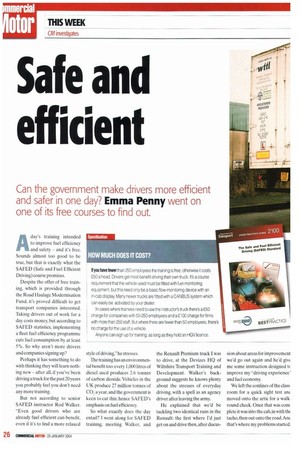Safe and efficient
Page 26

Page 27

If you've noticed an error in this article please click here to report it so we can fix it.
Can the government make drivers more efficient and safer in one day? Emma Penny went on one of its free courses to find out.
Aday's training intended to improve fuel efficiency and safety — and it's free. Sounds almost too good to be true. but that is exactly what the SAFED (Safe and Fuel Efficient Driving) course promises.
Despite the offer of free training, which is provided through the Road Haulage Modernisation Fund, it's proved difficult to get transport companies interested. Taking drivers out of work for a day costs money, but according to SAFED statistics, implementing a fleet fuel efficiency programme cuts fuel consumption by at least 5%. So why aren't more drivers and companies signing up?
Perhaps it has something to do with thinking they will learn nothing new — after all, if you've been driving a truck for the past 20 years you probably feel you don't need any more training.
But not according to senior SAFED instructor Rod Walker. "Even good drivers who are already fuel efficient can benefit, even if it's to find a more relaxed style of driving," he stresses.
The training has an environmental benefit too: every 1,000 litres of diesel used produces 2.6 tonnes of carbon dioxide. Vehicles in the UK produce 27 million tonnes of CO2 a year. and the government is keen to cut this; hence SAFED's emphasis on fuel efficiency.
So what exactly does the day entail? I went along for SAFED training, meeting Walker, and the Renault Premium truck I was to drive, at the Devizes HQ of Wiltshire Transport Training and Development. Walker's background suggests he knows plenty about the stresses of everyday driving, with a spell as an agency driver after leaving the army.
He explained that we'd be tackling two identical runs in the Renault: the first where I'd just get on and drive then, after discus sion about areas for improvement we'd go out again and he'd give me some instruction designed tc improve my "driving experience' and fuel economy.
We left the confines of the class. room for a quick sight test anc moved onto the artie for a walk. round check, Once that was corn. plete it was into the cab, in with the tacho. then out onto the road. Anc that's where my problems started. As someone who had never lriven a truck with a slap-over • ox I faced a learning curve akin to limbing Everest. It was certainly . challenge, especially as I have a errible habit of slightly slackenng my grip on the gearstick half vay through the gearchange. The esult: some pretty horrendous ear changing, many marks on Valker's score sheet, and a Skoda lriver who overtook and then vaved his hand in a less than riendly manner...
But it did get better, honest, End by the end of the drive I was nanaging to change gear in a more iredicta ble fashion!
Nalker speaks to driver
iowever, Walker did have some :omments to make on my drivrig — and plenty of suggestions or improvement. Gears, unsuririsingly, were one of the areas equiring more work;I only scored Mak" for vehicle sympathy.
The second run, as you'd expect, vas better. Walker had a much more active role this time, and was keen to ensure that I drove to ensure good fuel economy with a more relaxed style of driving; involving far more block changes (much easier once you've got to grips with the gearbox!). "Look for hazards, anticipate things, avoid unnecessary downshifts or braking," he told me. "Don't exceed speed limits — driving at 50mph rather than 40mph on an A-road will dramatically penalize your fuel efficiency." It was only once I'd finish the second drive, and we we back to the classroom to put t scores down on paper that I re ized I was being marked for t SAFED "exam".
The total number of faults w( added up, and an overall drivi score produced.
Next came two theory te; designed to assess my Highw Code and practical knowled This score was added to the dr ing score, and from that, Walt produced an overall figure. I h passed. but had missed a 'distil tion' rating by four points.
But I did return to CM'S ivc tower with a new SAFED highvest and a certificate and memb ship card, which is a useful inch, tion that a driver has complet the course successfully.
However, the course is oi part of the story. Driving for go fuel economy takes practi Walker warns:But it is less tini and less stressful — it all deper on your skill and willingness adjust your own driving style.'
























































































































































































